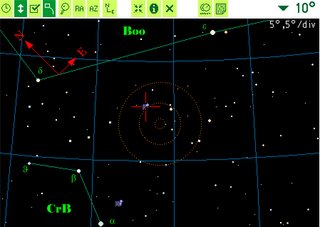Still Looking - Still TotL

Session Name: 20060419.2000
Still looking for 73P/Schwassmann-Wachmann 3 (2006) with no success. This graphic shows a 10° field of view with telrad circles and both comet elements B (upper) & C (lower). Charlie, Kin, and I have been looking with various small aperture optics ranging from binoculars to reflectors to refractors. The graphic shows naked eye orientation for 10pm EDT.
It is hard to believe that these comet elements are brighter than magnitude 9.5. I am confident with my ability to detect dim, extended objects exhibiting a low surface brightness and/or low contrast with the background sky, yet 73P-B & -C keep evading detection. (As a matter of fact, a previous night I was able to pick out NGC2903 where that exhibited such a low contrast with background sky that if one was not familair with it then it could easily escape detection. This extended object is magnitude 8.9 and estimated 60" ~ 75" in length.) I read at astroblog that the comet may be as bright as magnitude 8.2.
Update: Check out Jeremy's latest report & sketches at Belt of Venus.
At one point I began to defocus on a mag 9.4 star to see how large it would get before it disappeared. Unfortunately the clouds rolled through at this time and I didn't repeat the exercise later. I am uncertain of the size of the comet but imagine that 10" ~ 20" is not unreasonable to expect. So when I hear that an extended object is magnitude 8.2, or any magnitude for that matter, it is not the same as looking at a focused star of the same magnitude. The star of the same magnitude needs to be defocused to cover the same area that the extended object covers. Through the 4" Tak refractor and even Charlie's 4" F/4 reflector mag 9.5 ~ 10.0 required effort to resolve, so if the comet brightness is in this range then it is understandable why we don't see it. At magnitude 8.x I do expect to see "something". Well we'll keep trying.
Following are a few more Screenshots of Planetariun for the Palm (PftP) where Charlie and I have been starhopping and scanning the area looking for B & C. Both pictures show the field as seen from the Tak refractor with a diagonal, such that it is mirror reversed. A telrad finder is superimposed on the field for scale.
Puuuuuuuuuhleeeeeeeease let me know if these look wrong. Charlie and I were thinking even if the orbital elements were slightly off that the comet can't be far away, say 10' or 20'. And in a 2° field of view, one should still be able to see it.
73P/Schwassmann-Wachmann B is shown here near psi Boo as it appears in the refractor's eyepiece. All the stars shown within the outer telrad 2° field were observed. The limiting magnitude was set to 10. The grid is displaying alt/az.

73P/Schwassmann-Wachmann C is shown here near alpha CrB as it appears in the refractor's eyepiece. All the stars shown within the outer telrad 2° field were observed. The limiting magnitude was set to 10. The grid is displaying alt/az.

Since the weather has been nice the pedestrian traffic is a bit up. So of course, we showed off Saturn and M44, and Jupiter to thos ethat came later. Other objects we observed throughout the night included M13, M92, M57. These objects were observed with both low and medium powers. The globulars are both bright enough to see with ease though there brightness profiles differ. M13's brightness is more evenly distributed with a slight drop off on the periphery; in contrast, smaller M92's nulceus is a bright spike with the core and periphery dropping off more sharply. No details or stellar resolutions were detected in either cluster.
peter
<< Home